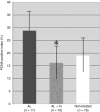Prevention of proliferative changes of forestomach mucosa by blood glucose control with insulin in alloxan-induced diabetic rats
- PMID: 19154414
- PMCID: PMC11158303
- DOI: 10.1111/j.1349-7006.2008.01081.x
Prevention of proliferative changes of forestomach mucosa by blood glucose control with insulin in alloxan-induced diabetic rats
Abstract
Diabetes mellitus is one of the risk factors for carcinogenesis. Recently we reported that alloxan induces squamous cell carcinoma (SCC) with coincidental inflammation, bacteria/fungal infections, and a severe diabetic condition. The present study was conducted to examine the effects of blood glucose control with insulin on the proliferative changes of the forestomach in alloxan-induced diabetic rats. Male 15-week-old WBN/Kob rats were divided into a control group of non-treated rats with naturally occurring diabetes after 40 weeks of age (non-treated group), alloxan-induced diabetic rats (AL group), and alloxan-induced diabetic rats given insulin implant treatment (AL + In group). The animals were sacrificed at 90 weeks of age for histopathologic examination. The blood glucose and urinary glucose level of the AL + In group fluctuated variously from high to normal levels compared with a constantly high level of AL (for 75 weeks) as well as in the non-treated group (for 50 weeks). The mucosal hyperplasia in the forestomach developed in 88.2% of the AL group and 37.5% of the non-treated group, but in only 10.0% of the AL + In group. SCC was only detected in 23.5% of the AL group. Hyperplastic changes were constantly accompanied by inflammation and fungal/bacterial infections in the AL and non-treated groups, whereas inflammation and fungal infection were completely suppressed in the AL + In group. These findings demonstrate that blood glucose control suppressed neoplastic changes in alloxan-induced diabetic rats. We postulate that inflammation together with bacterial/fungal infections under prolonged severe diabetic conditions play a pivotal role in carcinogenesis.
Figures






References
-
- Terai K, Sakamoto K, Goto M et al . Greater development of 1,2‐dimethylhydrazine‐induced colon cancer in a rat model of type 2 diabetes mellitus. J Int Med Res 2006; 34: 385–9. - PubMed
-
- Nunez NP, Oh WJ, Rozenberg J et al . Accelerated tumor formation in a fatless mouse with type 2 diabetes and inflammation. Cancer Res 2006; 66: 5469–76. - PubMed
-
- Ujpal M, Matos O, Bibok G, Somogyi A, Szabo G, Suba Z. Diabetes and oral tumors in Hungary: epidemiological correlations. Diabetes Care 2004; 27: 770–4. - PubMed
-
- Sandhu MS, Dunger DB, Giovannucci EL. Insulin, insulin‐like growth factor‐I (IGF‐I), IGF binding proteins, their biologic interactions, and colorectal cancer. J Natl Cancer Inst 2002; 94: 972–80. - PubMed
-
- Schoen RE, Tangen CM, Kuller LH et al . Increased blood glucose and insulin, body size, and incident colorectal cancer. J Natl Cancer Inst 1999; 91: 1147–54. - PubMed
MeSH terms
Substances
LinkOut - more resources
Full Text Sources
Medical
Research Materials

